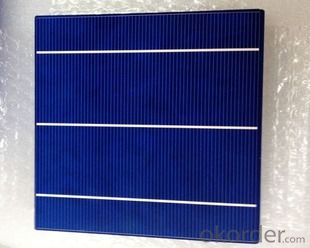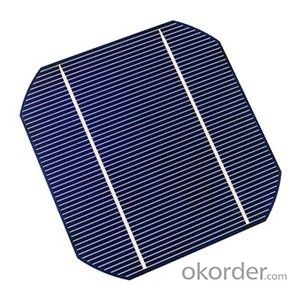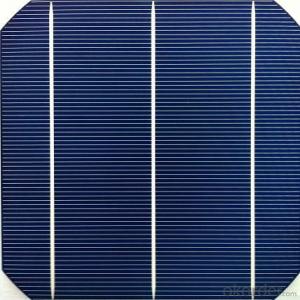High Efficiency Discount Satellite Solar Cells
- Loading Port:
- Shanghai
- Payment Terms:
- TT or LC
- Min Order Qty:
- 500 pc
- Supply Capability:
- 20000 pc/month
OKorder Service Pledge
OKorder Financial Service
You Might Also Like
| Size: | 156*156±0.5mm | Max. Power: | 3.99w | Product: | damaged solar cells |
| Pmp: | 3.99w | Vmp: | 0.516v | Imp: | 7.731A |
| Voc: | 0.621v | Isc: | 8.262A | Efficiency: | 16.25-16.50% |
| Thickness: | 190±20um | Format: | 156*156±0.5mm | FF: | 77.77% |
| Packaging & Delivery | |
| Packaging Detail: | Original Package, 100pcs in one boxes, 10boxes in one carton |
| Delivery Detail: | 1~2days |
| Specifications | |
| damaged solar cells | |
| solar cells in stock with immediate delivery with big quantity, all range cells avaiable, poly | |
Manufacturer
1,Components,ultra-white Executed tempered glass+PVB+cell+PVB+tempered glass
Glass+PVB+Cell+PVB+Glass
2,Components with ultra-white Executed tempered glass+PVB+cell+PVB+tempered glass+of PVB+tempered glass
Glass+PVB+Cell+PVB+Glass+PVB+Glass
Quality and Safety
1.Rigorous quality control meeting the highest international standards
2.High-transmissivity low-iron tempered glass, strong aluminium frame
3.Using UV-resistant silicon
4.ISO 9001:2008 and ISO 14001:2004
5.IEC61215, IEC61730, Safety Class in conformity to CE
Features
1.High conversion efficiencies resulting in superior power output performance.
2.Outstanding power output even in low light or high temperature conditions
3.Optimized design for ease of soldering and lamination
4.Long-term stability,reliability and performance
Warranties
1.10 years limited product warranty
2.15 years at 90% of the minimal rated power output
3.25 years at 80% of the minimal rated power output
Format: 156mm x 156mm
Thickness: 190um+-20um
Front(-): 1.7mm bus bars(silver),blue anti-reflecting coating(silicon nirtride)
back(+): 3mm wide soldering pads(silver) back surface field(aluminium)
| Size | 156mm x156mm ±0.5mm | |||||
| Thickness | 190um ± 20um | |||||
| Front surface(-) | 1.7mm bus bars(silver), blue anti-reflecting coating(Silicon nitride) | |||||
| Back surface (+) | 3mm wide soldering pads(silver) back surface field(Aluminum) | |||||
| TkVoltage | -0.351%/K | |||||
| TkCurrent | +0.035%/K | |||||
| TkPower | -0.47%/K | |||||
| Efficiency(%) | Pmp(W) | Vmp(V) | Imp(A) | Voc(V) | Isc(A) | FF(%) |
| 16.25-16.50 | 3.99 | 0.516 | 7.731 | 0.621 | 8.262 | 77.77 |
| 16.00-16.25 | 3.92 | 0.512 | 7.66 | 0.616 | 8.195 | 77.68 |
| 15.75-16.00 | 3.86 | 0.509 | 7.584 | 0.613 | 8.135 | 77.43 |
| 15.50-15.75 | 3.8 | 0.505 | 7.525 | 0.611 | 8.08 | 77.04 |
| 15.25-15.50 | 3.74 | 0.502 | 7.458 | 0.609 | 8.053 | 76.2 |
| 15.00-15.25 | 3.68 | 0.5 | 7.365 | 0.609 | 8.038 | 75.12 |
| 14.75-15.00 | 3.62 | 0.498 | 7.271 | 0.607 | 8.045 | 74.23 |
| 14.50-14.75 | 3.56 | 0.497 | 7.16 | 0.604 | 8.04 | 73.3 |
| 14.25-14.50 | 3.5 | 0.494 | 7.091 | 0.603 | 8.08 | 71.84 |
| 14.00-14.25 | 3.44 | 0.494 | 6.96 | 0.601 | 8.065 | 70.91 |
solar cell Pic. and drawing:



Benefits of Solar Power:
Now is a great time to go solar and harvest the power of the sun. Here is our top ten list of the benefits to installing solar power:
1, When installed, solar energy is free – no resources are consumed
2, Help to lessen our dependence on heavily polluting coal power stations
3, Fossil fuels can't last forever, future generations will appreciate the effort
4, You are gaining energy independence - add battery backup power for even greater energy security
5, The cost of electricity is only going to rise – insure against that rising cost
6, Quality solar power and water adds value and appeal to your home
7, Solar PV systems are easily upgraded in future - aim to make your house a net energy producer!
8, Solar panels offer a long lifetime of low maintenance service, maybe 30-40 years
9, Your friends will think you're great!
10, You'll feel great for doing your bit for the environment!
FAQ
1, What’s price per product ?
A: It’s depends on the quantity, delivery date and payment terms of the order. We can talk further about the detail price issue. Our products is high quality with lower price level.
2, How to make payment?
We accept T/T or L/C.
3, What is your lead time?
Generally 1-5 weeks depends on the order quantity and your specific requirements.
4, Can you do OEM for us?
Yes, we can.
5, How do you pack your products?
We have rich experience on how to pack the panels to make sure the safety on shipment when it arrives at the destination.
Some basic information about solar cell
Solar cells are devices which convert solar light energy directly into electricity and function by the photovoltaic effect. Photo- means light and -voltaic means electrical current or electricity (light-electricity). A solar cell provides direct current (DC) electricity that can be used to power DC motors and light bulbs among other things. Solar cells can even be used to charge rechargeable batteries so that electricity can be stored for later use when the sun is not available. The fully charged batteries are portable energy that can be used whenever and wherever they are needed.
Solar cells provide DC electricity similar to batteries however, batteries differ because they operate through a process known as an electrochemical reaction. This process will provide an electrical current (electro-) from a chemical reaction (-chemical) that occurs inside the battery. When you hook up a motor to the battery, also known as a load, the reaction begins and electrons flow as shown in the picture: "Battery Circuit". Direct current (DC electricity) is different from the alternating current (AC electricity) that is used to power the TV, refrigerator, and other appliances in your home however, DC can be converted to AC when needed.
Battery Circuit (large image)
Solar cells produce DC electricity from light. Sunlight contains packets of energy called photons that can be converted directly into electrical energy. You can’t see the photons but they hit the cell and produce free electrons that move through the wires and cause an electrical current as shown in the picture: "Solar Cell Circuit". The electrical current is the electricity that powers the motor. Although you can't see the photons you can see the light and you can assume that the amount of photons hitting your solar cell is related to the amount of light hitting your solar cell. A greater amount of light available means a greater amount of photons are hitting your solar cell and the more power you get from it.
Main technical parameters about solar cells
Cell Thickness
An optimum silicon solar cell with light trapping and very good surface passivation is about 100 µm thick. However, thickness between 200 and 500µm are typically used, partly for practical issues such as making and handling thin wafers, and partly for surface passivation reasons.
Doping of Base
A higher base doping leads to a higher Voc and lower resistance, but higher levels of doping result in damage to the crystal.
Reflection Control
(front surface typically textured)
The front surface is textured to increase the amount of light coupled into the cell.
Emitter Dopant
N-type silicon has a higher surface quality than p-type silicon so it is placed at the front of the cell where most of the light is absorbed. Thus the top of the cell is the negative terminal and the rear of the cell is the positive terminal.
Emitter Thickness
A large fraction of light is absorbed close to the front surface. By making the front layer very thin, a large fraction of the carriers generated by the incoming light are created within a diffusion length of the p-n junction.
Doping Level of Emitter
The front junction is doped to a level sufficient to conduct away the generated electricity without resistive loses. However, excessive levels of doping reduces the material's quality to the extent that carriers recombine before reaching the junction.
Grid Pattern.
The resistivity of silicon is too high to conduct away all the current generated, so a lower resistivity metal grid is placed on the surface to conduct away the current. The metal grid shades the cell from the incoming light so there is a compromise between light collection and resistance of the metal grid.
Rear Contact.
The rear contact is much less important than the front contact since it is much further away from the junction and does not need to be transparent. The design of the rear contact is becoming increasingly important as overall efficiency increases and the cells become thinner.
- Q: How do people price solar cells? Is it based on a specific way of calculating the cost of solar cells?
- Here is an example of doing the calculation, just for your reference: According to the same calculation method, 10 kilowatts of distributed photovoltaic power generation equipment to recover the cost of 9-10 years. Home photovoltaic power plant to recover the cost of the average period between 8-10 years.
- Q: How long does it take to install solar cells on a rooftop?
- The installation time for solar cells on a rooftop can vary depending on various factors such as the size of the system, complexity of the installation, and the experience of the installation team. However, on average, a typical residential installation can take anywhere from one to three days.
- Q: How much does a solar cell weigh?
- The weight of a solar cell typically varies depending on its size and type, but on average, a standard solar cell weighs around 3 to 4 pounds (1.4 to 1.8 kilograms).
- Q: Can solar cells be used for aerospace applications?
- Yes, solar cells can be used for aerospace applications. They are commonly used in satellites and space probes to provide power for various systems and instruments. Solar cells are lightweight, reliable, and can efficiently convert sunlight into electricity, making them ideal for powering spacecraft in the vastness of space where traditional power sources are not feasible.
- Q: Are solar cells affected by electromagnetic interference?
- Yes, solar cells can be affected by electromagnetic interference. Electromagnetic interference can degrade the performance of solar cells by disrupting the flow of electrons and causing fluctuations in output power. However, proper shielding and grounding techniques can be implemented to minimize these effects and ensure optimal functioning of solar cells.
- Q: Can solar cells be used in powering irrigation systems?
- Yes, solar cells can be used to power irrigation systems. Solar energy can be converted into electrical energy by solar cells, which can then be used to power irrigation pumps and other components of the system. This makes solar-powered irrigation systems a sustainable and environmentally friendly alternative to traditional methods of powering irrigation systems.
- Q: How do solar cells perform in areas with high levels of snowfall?
- Solar cells generally do not perform optimally in areas with high levels of snowfall. The accumulation of snow on the surface of solar panels can significantly reduce their efficiency by blocking sunlight and preventing the cells from generating electricity. Regular snow removal or tilting the panels at an angle can help mitigate this issue, but it may still impact their overall performance in such regions.
- Q: What is the role of tracking systems in solar cell installations?
- The role of tracking systems in solar cell installations is to optimize the efficiency and output of the solar panels by automatically adjusting their position and orientation throughout the day to maximize exposure to sunlight. This ensures that the panels are always facing the sun at the optimal angle, resulting in increased energy production and improved overall performance of the solar cell installation.
- Q: Can solar cells be used for portable devices?
- Yes, solar cells can be used for portable devices. Advances in technology have made it possible to miniaturize solar cells, making them suitable for powering various portable devices such as smartphones, tablets, and even wearable electronics. These devices can be charged directly from sunlight or through the use of portable solar panels, offering a sustainable and renewable source of power on the go.
- Q: How much space is required to install solar cells?
- The amount of space required to install solar cells depends on various factors such as the type and size of the solar cells, their efficiency, and the desired energy output. Generally, for residential installations, a few hundred square feet of roof space or an equivalent area in a yard is typically sufficient to accommodate a solar panel system. However, larger-scale solar power plants or commercial installations may require significantly more space.
Send your message to us
High Efficiency Discount Satellite Solar Cells
- Loading Port:
- Shanghai
- Payment Terms:
- TT or LC
- Min Order Qty:
- 500 pc
- Supply Capability:
- 20000 pc/month
OKorder Service Pledge
OKorder Financial Service
Similar products
Hot products
Hot Searches
Related keywords































